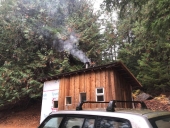Minor Update.
As I write this, it is July 2015, and obviously the winter heating season 2014/15 has ended. I never resumed the use of my flue damper. And I never noticed any trouble with just placing the fire bricks over the opening of my j-style rocket heater. I just kept closing the opening more and more, to 1.25 inch while the coals were dying down (the width of one fire brick split), and then just about an 1/8-inch or so open when I went to bed or to work. My thinking was this was enough to permit gases to escape, should any be present.
Other days, when the wind was from the "wrong" direction (I never got around to increasing the height of my chimney pipe, given this was a temporary and prototype build) I covered the feed tube opening first with a piece of heavy aluminum foil (still flexible, still for cooking use, just the heavy foil, not the very easily torn thin foil), then on top of the foil a couple of 12x12 inch floor tiles I had left over (which completely covered my feed tube opening), and then on top of the tiles, setting the three split fire bricks I used to moderate my feed tube opening when burning.
I cannot say that I ever detected a cold breeze flowing into the house using this set up. Thus, as of now, I am not convinced loss of heat is of great concern. Granted, I also did not simply allow a full 6-inch opening to remain fully open through my wall all winter either! But my opinion is that closing one end of a loop (feed tube, to barrel, to chimney pipe) is adequate to slow or halt the loss of indoor air to the atmosphere, to any appreciable degree.
I imagine a bottle, and trying to blow smoke into it, simulating a cold winter wind. How effectively does the smoke enter the bottle? How deeply? I am thinking, not so much. I'm not saying using a flue damper might not be a good idea; but my opinion is that it ought to be located in an obvious location, so that one remembers to *open* it before starting the new fire

hehehe, having forgotten once or twice

...I can say the fire tends to draw much better when the damper is open

Now, bear in mind that I live in an older house and I *do* have old windows and doors, so I already have "heat leakage" in the house; this is *not* anything like a super-tight house.






























 That seems a bit much, heheh
That seems a bit much, heheh








 hehehe, having forgotten once or twice
hehehe, having forgotten once or twice  ...I can say the fire tends to draw much better when the damper is open
...I can say the fire tends to draw much better when the damper is open 






-Finished-Rocket-with-integral-sand-mass-connected-to-external-mass.jpg)


